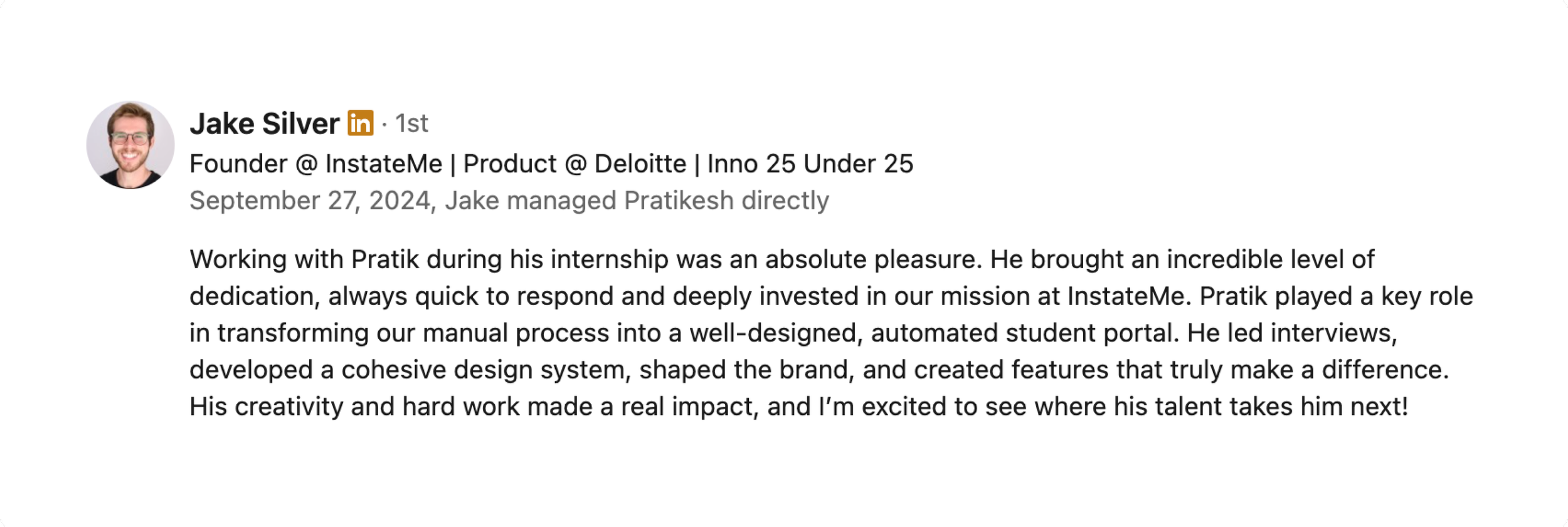
InstateMe was founded to simplify the residency process, inspired by a personal journey to make education accessible, saving students an average of $80,000 on tuition through expert guidance.
Client
InstateMe
My role
Led end-to-end process, established brand, conducted UX research, developed scalable design systems, and ensured delivery.
Duration
Four months
Tools used
Figma, Google Sheets, Docs, Forms, ChatGPT, Trello, Loom.
Project context
InstateMe began its journey in Texas, focusing on helping students at the University of Texas at Austin navigate the state residency process with personalized guidance. The company quickly achieved a 100% success rate within the region. However, as the business grew, challenges emerged with the existing tools, such as Google folders and spreadsheets.
Students and parents struggled with decentralized documentation, an inability to track progress, and a lack of motivation to complete tasks on time. Parents also found it difficult to assist their children effectively, and vice versa. Meanwhile, the owner faced overwhelming manual processes as the business scaled, making it challenging to maintain the high level of value and success the company was known for.
Through in-depth user journey mapping and close collaboration with stakeholders, I uncovered critical pain points and developed targeted success metrics.
Process approach
I began by aligning project expectations with business ROI and understanding the company’s story, value proposition, and stakeholder challenges. Next, I engaged with users to analyze their processes, challenges, and expectations. To ensure timely progress, I mapped user and business journeys, uncovering motivations, priorities, and mental workflows,
which informed the creation of user flows and concept designs. A critical aspect of the research was deriving the success matrix, involving current users and stakeholders throughout, and framing the process within a 1.5-month timeline to deliver an impactful report.
A key insight from the research was aligning user expectations with business goals, leading to a high-impact success matrix that served as a common ground for both stakeholders and users.
User Conversion
Increase lead-to-subscriber conversion rates through an effective signup and education journey.
Process Transparency
Enhance user satisfaction with centralized document management, personalised progress tracking, and effective notifications.
Task Completion
Ensure timely task submissions with improved collaboration tools and accountability features.
First Iteration: Prototype for Task & Journey Tracking
Based on research insights and key factors shaping the success matrix, I first developed a concept wireframe addressing three core aspects: tracking status over the years, visualizing the user journey, and managing task deadlines with estimated completion times,
along with a task page where users can view both the task list and detailed step-by-step instructions.
Second Iteration: Refining the Experience Through User Collaboration
To refine the prototype, I conducted a user feedback session with six participants, allowing them to navigate the design independently and share their thoughts. The session was conducted online with recorded calls (with user consent) and handwritten notes documenting key insights. After thoroughly analyzing the feedback with the team, we made critical design updates. Users preferred a vertically aligned tracker for better progress tracking, so we adjusted the layout accordingly.
We also introduced a recent comments section for parents while removing the flag feature. A key recommendation emerged—leveraging the comment feature as an alert system to notify and remind users to complete tasks on time. Additionally, working closely with the team, I enhanced the task filtering system with improved tagging, making it more intuitive and easier to navigate.
This aggregated feedback from eight usability sessions reveals key insights that informed critical design improvements.
An iterative design process driven by user feedback refined the tracker to clearly convey progress, timelines, current status, and actions.
As a critical component of the dashboard, the tracker needed to be both intuitive and purpose-driven to meet user expectations. I approached its design with active user feedback, ensuring it provided immediate clarity on current status, anticipated actions, and upcoming deadlines.
The final design enables users to quickly scan progress, understand next steps, and stay aware of remaining days, enhancing both usability and engagement.
Scalable Task System Design Reducing Development Effort by 30%
One of the biggest challenges in designing the task system was handling complex, state-specific legal requirements and undefined tasks in the current InstateMe process. To address this, I developed a scalable task taxonomy that organizes tasks by content and context, ensuring flexibility for future additions and clarity for developers.
The modular task components I created are reusable, adaptable to varying state laws, and streamlined backend integration, reducing developer effort by 30%.”
Designing an effective onboarding flow was crucial in addressing key pain points from user journey mapping. Stakeholder insights emphasized trust, transparency, and human connection as core values, guiding our approach to create an intuitive and reassuring user experience.
Storytelling for Trust – We introduced the company’s mission through an engaging narrative, using the founder’s voice to create authenticity before users navigate to the quiz.
Simplifying a Complex Process – Given the legal complexities of residency eligibility, we designed a structured Q&A format that guides users through the process in a clear, supportive, and positive tone.
Building Confidence & Engagement – We provided clear context for every question, reassuring users about why certain information is required while incorporating testimonials to establish credibility.
Driving Business Impact – The onboarding flow was designed not only to generate leads but also to reduce manual dependencies, ensuring users find answers to common questions while fostering trust and conversion.
Designing a Clear and Actionable Dashboard
The dashboard was designed to provide status clarity, motivation for actions, and seamless tracking of due dates and tasks within a monthly timeline. The tracker element, developed iteratively with real users, became the most crucial and complex feature—v
visualizing a year-long journey, current status, and task performance to improve residency approval chances. Key features include a calendar view for upcoming due dates, a prioritized task list, and a comment section for parent feedback on specific tasks.
Streamlining Tasks for Clarity and Collaboration
Tasks are the core of this product, but user research revealed challenges like complexity, lack of guidance, and low motivation due to students’ busy schedules. To address this, we designed a simple, straightforward task layout with clear categorization, approximate completion times, and a vertical scroll flow with a step indicator for easy navigation.
Each task is structured into three parts: introduction, educational materials, and final submission. Alert badges were introduced to catch attention and encourage action, displaying only if a task is due within a week. Additionally, parents can access the portal to tag specific steps and leave comments, serving as flags to notify students or vice versa, ensuring seamless collaboration and timely action.

Final Thought
The InstateMe project streamlined a complex process, helping students with collaboration tools, decision trackers, and increased residency success rates while saving money. It reduced manual intervention, fostering trust and freeing the owner to focus on growth. While real-time user testing was extensive, scaling the portal to a larger audience will address complex scenarios like task dependencies impacted by changing state laws.
Success Metrics
Application Completion
Rate
A high completion rate shows the process is user-friendly and meets user needs.
Target: 90%
Simplification Drives Adoption
Streamlining workflows increased engagement, reduced drop-offs, and highlighted the impact of clear instructions on user success.
Time to Complete Application
Faster processes improve satisfaction and reduce drop-off rates.
Target: Under 20 minutes
Error Rate in Application Submission
Fewer errors create a smoother user experience and reduce administrative work.
Target: Below 5%
User Retention
Rate
High retention indicates ongoing value and effective platform use.
Target: 75%+
Project impact
30%
Reduction in Development Costs
Achieved through a scalable design system that follows accessibility guidelines, ensuring efficiency and long-term usability.
-
The 30% cost savings were calculated based on the reduction in developer time spent on designing each task due to the standardization of the task module. Before standardization, developers spent an average of 10 hours per task, which was reduced to 7 hours by reusing predefined components through an atomic design approach. This resulted in a 30% time savings ( {10 - 7}/{10} x100 ), directly translating into cost savings. For a project with 100 tasks and a developer hourly rate of $50, this saved 300 hours or $15,000. The 30% reflects actual tracked improvements, with further savings requiring additional optimizations like automation.
4.5/5
User Satisfaction Score (CSAT):
High satisfaction reflects an intuitive, well-structured application process that meets user needs effectively.
-
User satisfaction was measured through a survey of 24 participants, who rated their experience on a scale of 1-5. The average score was 4.5/5, reflecting a highly positive response to the platform’s intuitive design and seamless process.
95%
Willingness to Enroll After Experiencing the New UX
A majority of users expressed confidence in the platform, highlighting the impact of the improved user experience in increasing engagement and adoption.
-
A survey of 24 participants revealed that 95% of users expressed willingness to enroll after using the redesigned platform. This demonstrates the platform’s ability to build trust and confidence through features like progress tracking and collaborative tools.
Learnings
Process Optimization
with AI tools
Integrating AI tools with human collaboration significantly reduced synthesis time, optimized workflows, and ensured timely delivery without compromising quality.
Collaborative Problem-Solving
Cross-team collaboration bridged user needs and technical feasibility, delivering innovative solutions like real-time progress indicators and an intuitive portal.
Metrics-Driven Design
Tracking KPIs (e.g., success rates, CSAT) and user feedback informed meaningful design iterations and validated effectiveness.
Scalability and Future Opportunities
The platform is scalable for other processes, with the potential for AI integration and broader institutional adoption.















